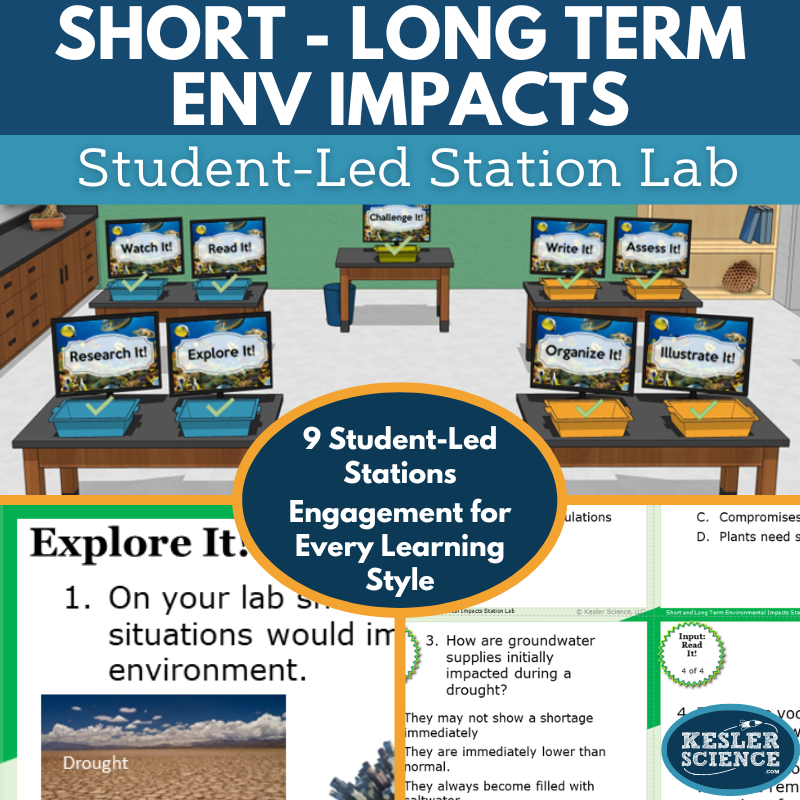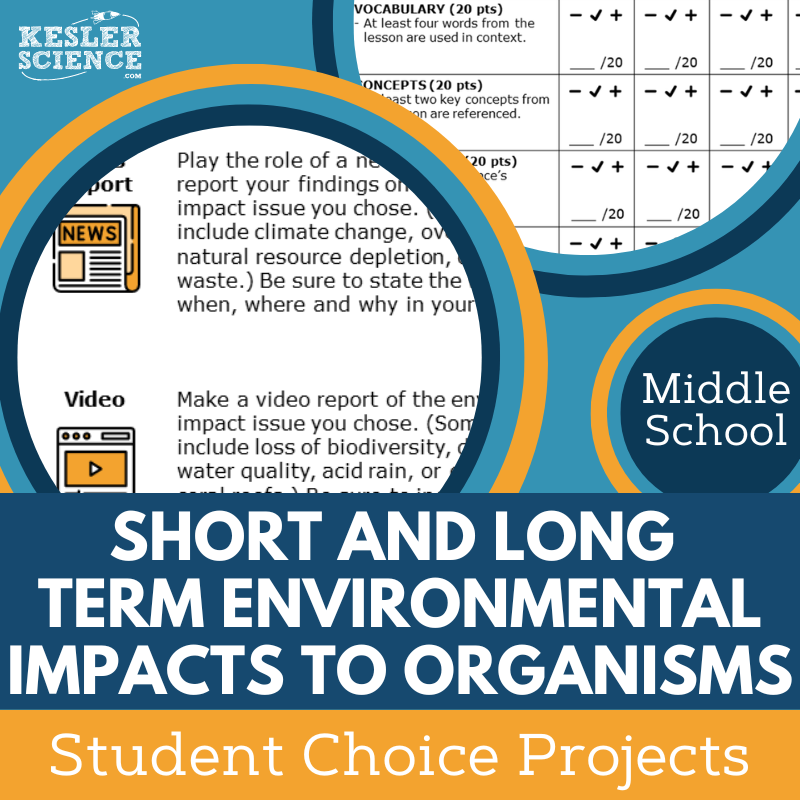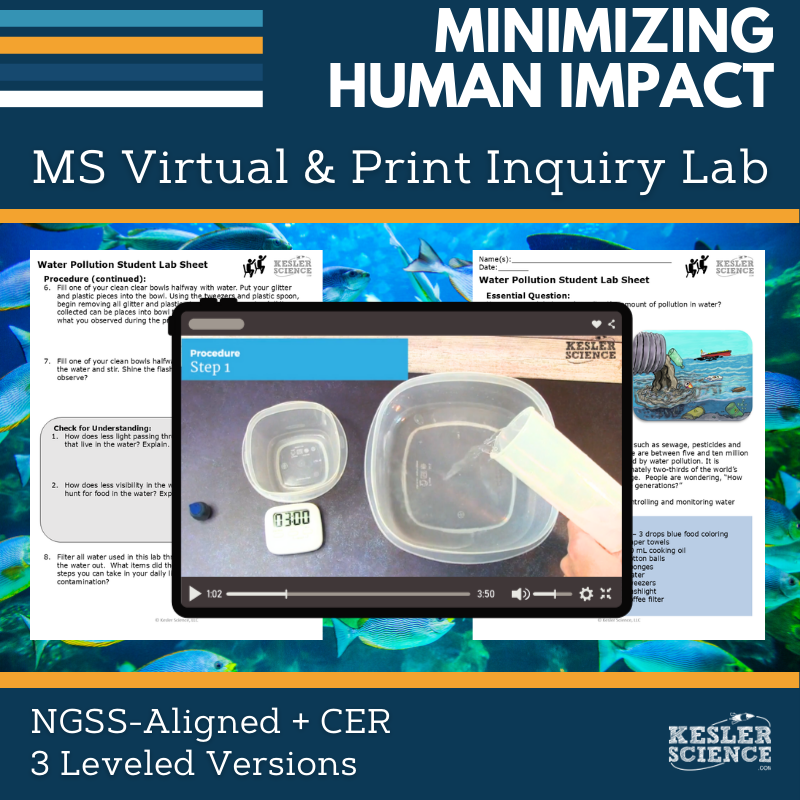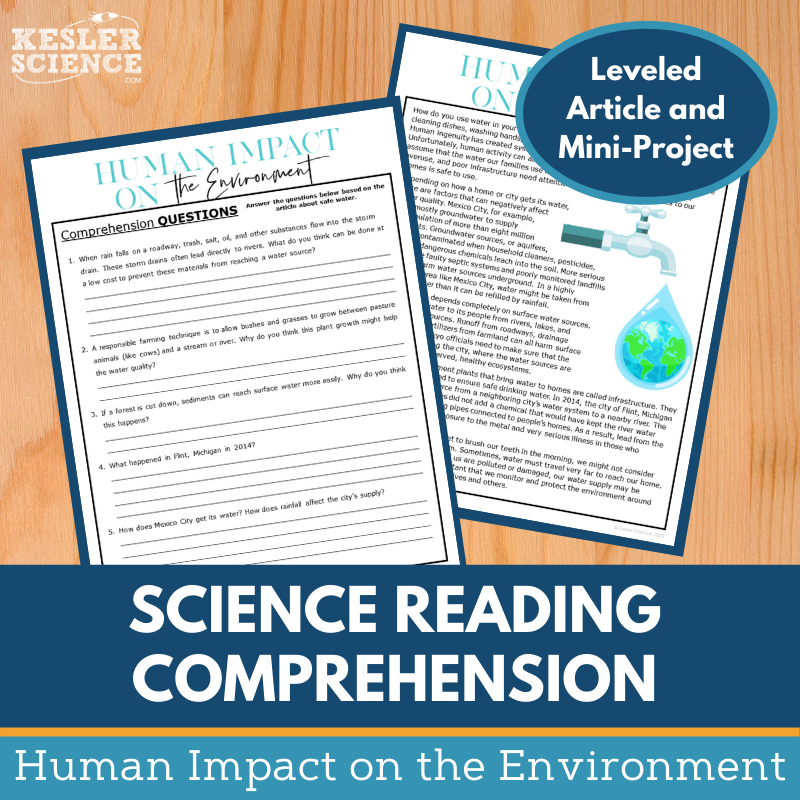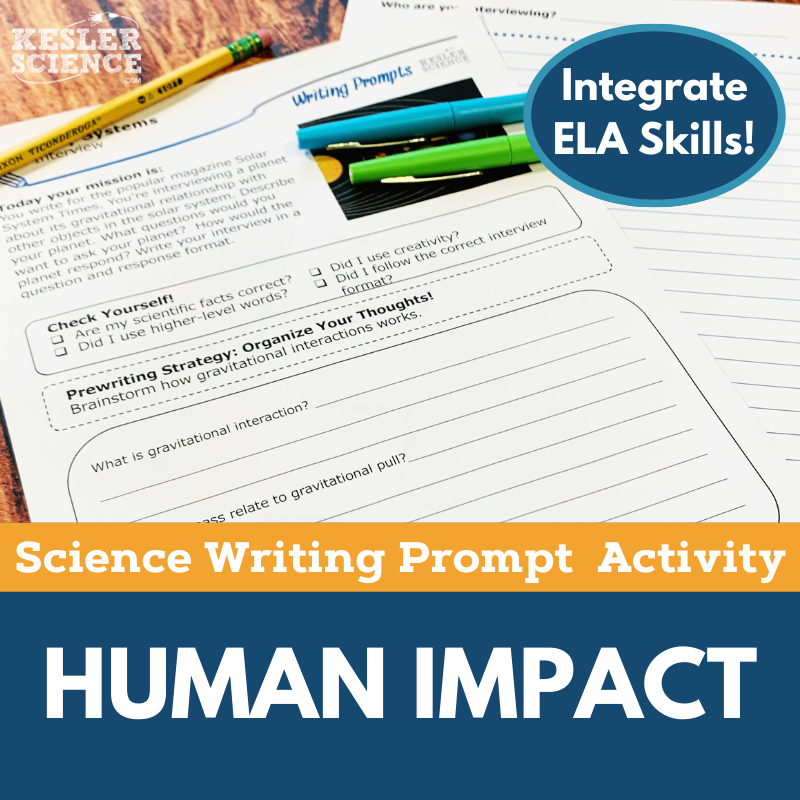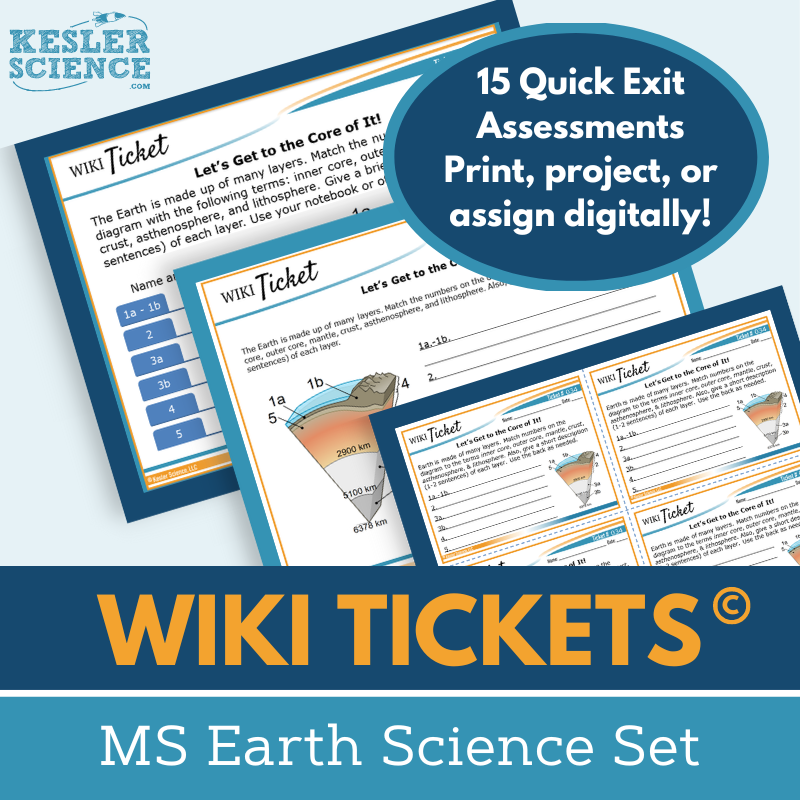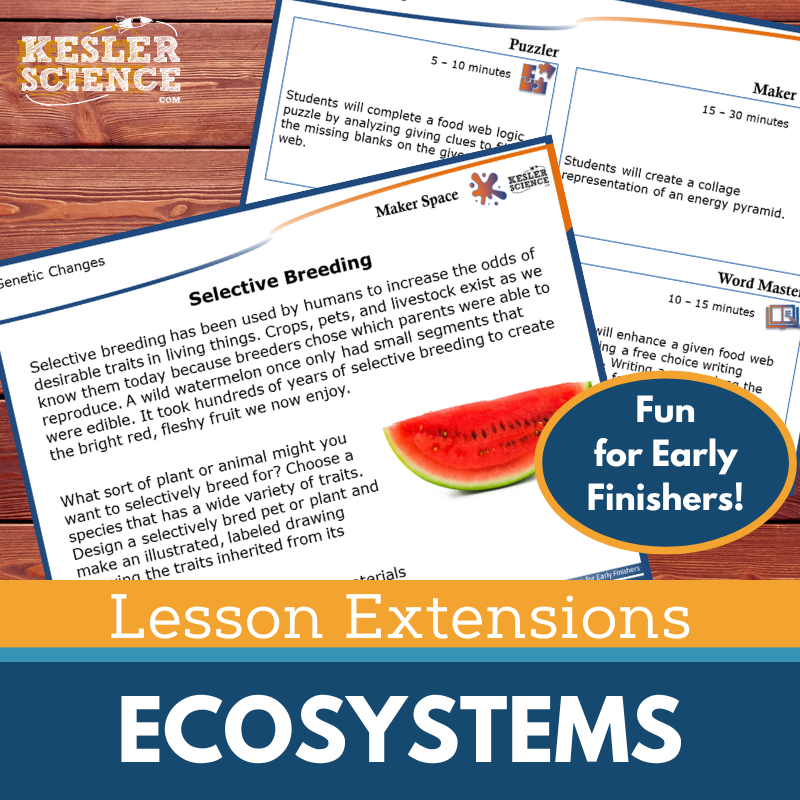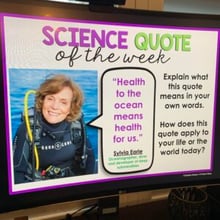Minimizing Human Impact Activities for Middle School Science
Students will investigate short- and long-term environmental impacts through engaging, student-led activities in this 5E lesson. The resources below will give students a comprehensive understanding of human impacts on the environment. All of the following materials are also included in the Kesler Science Membership.
The Kesler Science Short- and Long-Term Environmental Impacts 5E Lesson is a comprehensive, student-led unit designed for middle school learners. It includes editable presentations, worksheets, assessments, and student-choice projects, all requiring minimal prep. The lesson follows the 5E Model with resources for each stage: engaging class discussions, a hands-on exploration station lab with differentiated multimodal activities, and editable PowerPoints with interactive notebook templates in English and Spanish.
Students explore environmental changes through a variety of stations, including hands-on experiments, reading comprehension, research, video discussions, categorization exercises, writing prompts, illustration activities, and assessments. A bonus challenge station extends learning for advanced students. The lesson also offers differentiated assessments aligned with STAAR 2.0 and flexible formats for both in-class and virtual learning.
The Kesler Science Short- and Long-Term Environmental Impacts 5E Lesson is a comprehensive, student-led unit designed for middle school learners. It includes editable presentations, worksheets, assessments, and student-choice projects, all requiring minimal prep. The lesson follows the 5E Model with resources for each stage: engaging class discussions, a hands-on exploration station lab with differentiated multimodal activities, and editable PowerPoints with interactive notebook templates in English and Spanish.
Students explore environmental changes through a variety of stations, including hands-on experiments, reading comprehension, research, video discussions, categorization exercises, writing prompts, illustration activities, and assessments. A bonus challenge station extends learning for advanced students. The lesson also offers differentiated assessments aligned with STAAR 2.0 and flexible formats for both in-class and virtual learning.
Engage your middle school students with this student-led station lab on short- and long-term environmental impacts. Designed for in-class or virtual learning, this modular activity allows students to direct their own learning through nine interactive stations, incorporating videos, readings, research, and hands-on tasks.
Students explore new concepts through multimodal input stations, including hands-on demonstrations, research activities, reading passages, and video analysis. They then demonstrate their understanding through output stations that involve organizing information, illustrating models, writing responses, and completing assessments. A bonus challenge station provides extension activities for early finishers, and differentiated reading passages in English and Spanish support diverse learners.
This high-engagement, low-prep resource fosters critical thinking and independent learning, making it a valuable addition to any ecosystems lesson.
Engage your middle school students with this student-led station lab on short- and long-term environmental impacts. Designed for in-class or virtual learning, this modular activity allows students to direct their own learning through nine interactive stations, incorporating videos, readings, research, and hands-on tasks.
Students explore new concepts through multimodal input stations, including hands-on demonstrations, research activities, reading passages, and video analysis. They then demonstrate their understanding through output stations that involve organizing information, illustrating models, writing responses, and completing assessments. A bonus challenge station provides extension activities for early finishers, and differentiated reading passages in English and Spanish support diverse learners.
This high-engagement, low-prep resource fosters critical thinking and independent learning, making it a valuable addition to any ecosystems lesson.
The Short and Long-Term Environmental Impacts Student Choice Projects align with NGSS science standards, allowing middle school students to demonstrate their understanding in a way that suits their preferred output style. A project page outlines six structured student-led options plus a “design your own” project, all with an editable rubric for teacher, peer, or self-assessment.
These flexible, multimodal projects offer creative ways for students to engage with the content. Two versions of the project page provide differentiation, with modified options for students needing remediation and challenge opportunities for advanced learners. Teachers can adjust the rubric to fit their grading needs.
The projects use standard classroom supplies like paper, markers, and scissors, with many options available for digital completion. Some crafting supplies may be useful for model-building activities.
The Short and Long-Term Environmental Impacts Student Choice Projects align with NGSS science standards, allowing middle school students to demonstrate their understanding in a way that suits their preferred output style. A project page outlines six structured student-led options plus a “design your own” project, all with an editable rubric for teacher, peer, or self-assessment.
These flexible, multimodal projects offer creative ways for students to engage with the content. Two versions of the project page provide differentiation, with modified options for students needing remediation and challenge opportunities for advanced learners. Teachers can adjust the rubric to fit their grading needs.
The projects use standard classroom supplies like paper, markers, and scissors, with many options available for digital completion. Some crafting supplies may be useful for model-building activities.
The Minimizing Human Impact Lab aligns with NGSS MS-ESS3-3, guiding students to design a method for monitoring and minimizing water pollution. This resource includes both a hands-on printed experiment and a fully virtual interactive version, allowing flexibility in instruction. Each version includes comprehension questions, Claim-Evidence-Reasoning (C.E.R.) prompts, and a reflection section.
The lab is differentiated into three levels: Dependent (guided inquiry with procedural support), Modified (structured with sentence stems and multiple-choice options), and Independent (student-led with minimal guidance). The digital version includes an interactive PowerPoint compatible with Google Slides, featuring a pre-recorded video of the lab procedure. The print format provides a hands-on experience with standard classroom materials like a rectangular pan, clear bowl, graduated cylinder, spoon, dropper, glitter, milk, cooking oil, plastic pieces, coffee filter, flashlight, tweezers, water, sponges, cotton balls, and paper towels.
Editable teacher resources include PowerPoints, answer keys, and CER statements. The materials are designed for multimodal learning, ensuring engagement and accessibility for all students.
The Minimizing Human Impact Lab aligns with NGSS MS-ESS3-3, guiding students to design a method for monitoring and minimizing water pollution. This resource includes both a hands-on printed experiment and a fully virtual interactive version, allowing flexibility in instruction. Each version includes comprehension questions, Claim-Evidence-Reasoning (C.E.R.) prompts, and a reflection section.
The lab is differentiated into three levels: Dependent (guided inquiry with procedural support), Modified (structured with sentence stems and multiple-choice options), and Independent (student-led with minimal guidance). The digital version includes an interactive PowerPoint compatible with Google Slides, featuring a pre-recorded video of the lab procedure. The print format provides a hands-on experience with standard classroom materials like a rectangular pan, clear bowl, graduated cylinder, spoon, dropper, glitter, milk, cooking oil, plastic pieces, coffee filter, flashlight, tweezers, water, sponges, cotton balls, and paper towels.
Editable teacher resources include PowerPoints, answer keys, and CER statements. The materials are designed for multimodal learning, ensuring engagement and accessibility for all students.
This Science Reading Comprehension Lesson explores human impact on the environment through a nonfiction article and watershed analysis of a world city. Designed for middle school students, the leveled passage enhances science literacy and reading comprehension.
The resource includes two leveled articles (Lexile 1100-1300), five to seven comprehension questions, a hands-on mini-project, and a Cornell notes template. Engaging graphics can be printed in grayscale.
Ideal for sub plans, ISS, extra credit, or whole-class instruction, this resource fosters critical thinking, discussion, and textual analysis. Compatible with Google Classroom, MS Teams, Schoology, and Canvas, it supports both in-person and virtual learning.
This Science Reading Comprehension Lesson explores human impact on the environment through a nonfiction article and watershed analysis of a world city. Designed for middle school students, the leveled passage enhances science literacy and reading comprehension.
The resource includes two leveled articles (Lexile 1100-1300), five to seven comprehension questions, a hands-on mini-project, and a Cornell notes template. Engaging graphics can be printed in grayscale.
Ideal for sub plans, ISS, extra credit, or whole-class instruction, this resource fosters critical thinking, discussion, and textual analysis. Compatible with Google Classroom, MS Teams, Schoology, and Canvas, it supports both in-person and virtual learning.
The Human Impact on Environment Science Writing Prompt Activity engages middle school students in an invention-based writing exercise to apply their knowledge of environmental science. Aligned with NGSS MS-ESS3-3, this student-centered activity challenges learners to design a method for monitoring and minimizing human impact on the environment. It fosters science reasoning, creativity, and exploration while supporting both in-person and virtual learning.
This resource includes teacher directions with an answer guide, project ideas, and rubrics. It features projection-ready and print handouts in both full-size and half-sheet formats, incorporating pre-writing strategies and self-check components. A digital interactive PowerPoint version, compatible with Google Slides, allows for seamless remote or in-person use.
Ideal for cross-curricular activities, pre-test assessments, student choice projects, and differentiation, this writing prompt encourages engagement and science literacy. It can also serve as extra credit, make-up work, or a TELPAS writing sample. A great addition to any classroom, these writing activities can be displayed on bulletin boards or compiled into student anthologies.
The Human Impact on Environment Science Writing Prompt Activity engages middle school students in an invention-based writing exercise to apply their knowledge of environmental science. Aligned with NGSS MS-ESS3-3, this student-centered activity challenges learners to design a method for monitoring and minimizing human impact on the environment. It fosters science reasoning, creativity, and exploration while supporting both in-person and virtual learning.
This resource includes teacher directions with an answer guide, project ideas, and rubrics. It features projection-ready and print handouts in both full-size and half-sheet formats, incorporating pre-writing strategies and self-check components. A digital interactive PowerPoint version, compatible with Google Slides, allows for seamless remote or in-person use.
Ideal for cross-curricular activities, pre-test assessments, student choice projects, and differentiation, this writing prompt encourages engagement and science literacy. It can also serve as extra credit, make-up work, or a TELPAS writing sample. A great addition to any classroom, these writing activities can be displayed on bulletin boards or compiled into student anthologies.
The WIKI Tickets© Earth Science formative assessments provide engaging and flexible ways to check student understanding in 6th-8th grade science. This set includes 15 assessments, each available in five formats: a full-screen projection version, three print handouts, and an interactive digital version compatible with PowerPoint and Google Slides.
Aligned with NGSS and TEKS standards, these assessments cover topics such as ecoregions in Texas, human impact on the environment and natural resources, plate tectonics, the rock cycle, and groundwater resources. Some standards have multiple tickets, and a table of contents file is included for alignment reference.
Designed for both in-person and virtual learning, WIKI Tickets© can be used as exit tickets, bellringers, or quick checks. They can be projected for whole-class responses, printed in various formats, or assigned digitally. These assessments offer a simple, effective way to gauge student progress in earth science.
The WIKI Tickets© Earth Science formative assessments provide engaging and flexible ways to check student understanding in 6th-8th grade science. This set includes 15 assessments, each available in five formats: a full-screen projection version, three print handouts, and an interactive digital version compatible with PowerPoint and Google Slides.
Aligned with NGSS and TEKS standards, these assessments cover topics such as ecoregions in Texas, human impact on the environment and natural resources, plate tectonics, the rock cycle, and groundwater resources. Some standards have multiple tickets, and a table of contents file is included for alignment reference.
Designed for both in-person and virtual learning, WIKI Tickets© can be used as exit tickets, bellringers, or quick checks. They can be projected for whole-class responses, printed in various formats, or assigned digitally. These assessments offer a simple, effective way to gauge student progress in earth science.
Lesson Extensions provide engaging, student-choice activities designed to challenge early finishers and deepen their understanding of ecosystem standards. These activities help fill downtime, reinforce critical thinking, and keep students engaged with rigorous yet enjoyable learning opportunities. Aligned with NGSS and TEKS, they support independent learning and enrichment in ecosystem science.
Each extension includes four interactive components: Puzzler for problem-solving, Maker Space for hands-on STEAM activities, Tech Connection for digital demonstrations, and Word Master for creative writing. With teacher directions, answer keys, and both print and projection versions, these extensions are perfect for lesson wrap-ups, enrichment, or independent challenges, ensuring students remain engaged and learning at a deeper level. Topics covered include biodiversity, biomes, ecological succession, human impact, food webs, photosynthesis, reproduction, and more.
Lesson Extensions provide engaging, student-choice activities designed to challenge early finishers and deepen their understanding of ecosystem standards. These activities help fill downtime, reinforce critical thinking, and keep students engaged with rigorous yet enjoyable learning opportunities. Aligned with NGSS and TEKS, they support independent learning and enrichment in ecosystem science.
Each extension includes four interactive components: Puzzler for problem-solving, Maker Space for hands-on STEAM activities, Tech Connection for digital demonstrations, and Word Master for creative writing. With teacher directions, answer keys, and both print and projection versions, these extensions are perfect for lesson wrap-ups, enrichment, or independent challenges, ensuring students remain engaged and learning at a deeper level. Topics covered include biodiversity, biomes, ecological succession, human impact, food webs, photosynthesis, reproduction, and more.
This Amazing Anchors Phenomenon Lesson introduces and reinforces the concept of habitat through real-world connections. The two-part resource includes an introductory reading on wildlife conservation with comprehension and extension questions to prepare students for deeper learning. An explanatory reading explores the impact on animal habitats and human populations in an accessible way, with additional questions to reinforce understanding.
Aligned with NGSS standard ESS3-3, this no-prep resource includes teacher directions, answer keys, projection slides, and both print and digital formats for Google Classroom and other LMS platforms. A modified version provides differentiated language and sentence starters to support student comprehension. Designed to bookend a main lesson, these readings serve as engaging supplements for the Engagement and Elaborate segments of 5E lessons in both in-person and virtual classrooms.
This Amazing Anchors Phenomenon Lesson introduces and reinforces the concept of habitat through real-world connections. The two-part resource includes an introductory reading on wildlife conservation with comprehension and extension questions to prepare students for deeper learning. An explanatory reading explores the impact on animal habitats and human populations in an accessible way, with additional questions to reinforce understanding.
Aligned with NGSS standard ESS3-3, this no-prep resource includes teacher directions, answer keys, projection slides, and both print and digital formats for Google Classroom and other LMS platforms. A modified version provides differentiated language and sentence starters to support student comprehension. Designed to bookend a main lesson, these readings serve as engaging supplements for the Engagement and Elaborate segments of 5E lessons in both in-person and virtual classrooms.
Year-Round Resources
These year-round activities will increase your students' understanding of many middle school science topics. All of these activities are also included in the Kesler Science Membership.
Visual Data & Graphing
You're not alone if your students struggle with understanding graphs, charts, and tables. It's a skill that takes an enormous amount of practice. This resource will help students build a strong foundation in analyzing data and creating their own data visualizations.
Bell Ringers and Warm-Ups
These middle school science bell ringers are an excellent way to engage your students as soon as they walk into your classroom. This comprehensive FULL YEAR resource includes everything you need to start off each science class with an interesting warm-up activity.
Review Board Games
Each game board has been carefully designed to keep students engaged. There are 10 different action spaces on each board and dozens of question cards. All of the actions are related to science concepts and keep the students motivated throughout the game.
Each game is ready to play. Simply print out the board and the cards and let the students enjoy reviewing nine different units.
Essential Questions and Standards
Below are the essential questions and standards associated with the lessons and activities included in the minimizing human impacts unit. This topic is only one of more than 100 middle school science topics included in the Kesler Science Membership.
-
How do environmental changes (both short- and long-term) affect organisms and traits in subsequent populations?
-
NGSS - MS-ESS3-3 Minimizing Human Impact
Kesler Science Membership
Imagine never having to search for another middle school science lesson again. The membership gives you access to ALL of the Kesler Science products in one place (Yes, including everything above).
Say goodbye to long hours of lesson prep.



